|
Me Sahyadri |
|
March 2018 |
|
Volume 5, number 5, # 59 |
|
Mysteries of Maval Caves – Velhavali Khandshi Tunnel Caves – Black holes |
Please use minimum 1280 pixel horizontal screen resolution for viewing. Please be patient while all the images in webpage are loaded. Please do not use the images for any commercial use without permission. Text in Marathi and English is not exact translation. Please give sufficient time to allow the photographs to load. Special thanks to Mr. Sangram Garud (Sangise)and Mr. Abaji Bhavri (Khandshi) and all those who helped us during the compilation and for the help and guidance during the activity. |
|
|
|
|
देशाची आर्थिक प्रगती व्हावी असे सर्व नागरिकांना वाटणे सहाजिक आहे. अर्थकारणामुळे मिळणारा रोजगार, समृद्धी यासाठी सर्वांनाच आर्थिक प्रगती हवी हवीशी वाटते. आर्थिक प्रगती होताना, त्याचा दिर्घकाळात समाजावर, निसर्गावर, वातावरणावर दुष्परिणाम होणार नाही याची काळजी घेणे महत्वाचे आहे. मनुष्याच्या भावी पिढ्यांना पाणी, शुद्ध हवा, योग्य वातावरण मिळत रहावे अशी भावना मनात रुजणे महत्वाचे आहे. वाढत्या आर्थिक प्रगतीमुळे नैसर्गिक संपदेवर ताण येतो. प्रगतीसाठी प्रदुषण होते. जंगले, माळराने, व इतर अधिवास नष्ट होतात. वसुंधरेवर रहाणाऱ्या इतर जीवांचा मात्र मनुष्य फारसा विचार करत नाही. आर्थिक प्रगती करताना, मनुष्य निसर्गाची हानी करत आहे. मुळताच माणसाला निसर्गाचे महत्व समजणे हे सध्याच्या आपल्या प्रगत जीवनशैली मुळे अवघड झाले आहे. आर्थिक प्रगती, समाजाची प्रगती व निसर्ग संपदेची निगा, यांचा समतोल राखणे काळाची गरज आहे.
सह्याद्री (पश्चिम घाट) हा एक नैसर्गिक संपदेचा, वैविध्यतेचा, भौगोलिक व ऐतिहासिक ठेवा आहे. वाढत्या मानवी अतिक्रमणाचा, सह्याद्रीच्या विविध घटकांवर होणारा दुष्परिणाम भविष्यात आपल्यालाच धोका निर्माण करेल, यात शंका नाही. शुद्ध पाणी, हवा व उर्जा, भावी पिढीला मिळण्यासाठी, नंद्यांचे उगम असलेला सह्याद्री व त्याभागातील जंगले टिकवणे महत्वाचे आहे. सह्याद्रीच्या महत्वाच्या घटकांचे महत्व छायाचित्रांद्वारे प्रकट करण्याचा मी येथे प्रयत्न केला आहे. येथील पक्षी, प्राणी, वनस्पती, अधिवास, किल्ले व लेणी अशा विविध विषयांबद्दल आपण समजुन घेऊ.
|
|
As the economic development has taken the center stage, the balance between the environmental sustenance and socio economic development will be under the scanner. As most experts with balanced views have proclaimed, Indian wildlife and ecological system sustenance will be under threat, unless precautions are taken with the help of appropriate research and long term national interests. As we encounter the economic development, many habitats which indirectly or directly help sustainable development will be damaged. The awareness to gauge the success by sustainable development and not by year to year growth is a distant dream any environmentalist will assume in current scenario.
Western ghats, or Sahyadri as we all call it as, is a treasure trove of spectacular landscapes, biodiversity, flora, fauna, some amazing geological wonders and man made monuments. With the increasing pressure from human encroachment, all these elements are under stress and in turn are under depletion. Western ghats should be left untouched by human beings, to protect their future generations from getting short of resources, such as water, energy and clean air. The important elements of western ghats, which need protection are highlighted in the new version of Photo journal, Me Sahyadri Magazine.
|
|
|
| |
 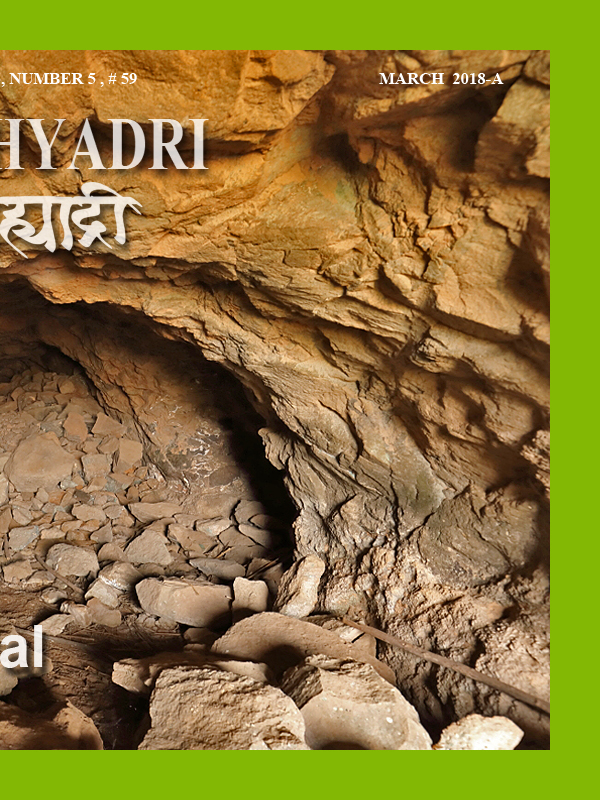
|
| |
| Me Sahyadri – March 2018 - A
|
| |
|
|
मावळ लेणी मोहेमेचा सारांश :
मावळातल्या लहान लेण्यांचा शोध घेण्यात जेवढे कष्ट पडले, तेवढेच कष्ट बेडसे, कार्ले, आणि भाजे च्या लेण्यांतील बारकावे समजवुन घेताना पडले. या लेखात कार्ले लेण्यातील काही सुंदर बारकाव्यांचा पसारा मी इथे मांडला आहे.
मावळातील भाजे, बेडसे आणि कार्ले लेणी अप्रतिम आहेत. त्यामुळे या भागातील इतर लहान लेण्यांकडे फारसे कोणी फिरकत नाही. आम्ही चार समविचारी मित्रांनी मात्र या हरवलेल्या लेण्यांची शोधाशोध करण्याचे ठरवले. साईप्रकाश बेलसरे, निनाद बारटक्के, अमेय जोशी आणि विवेक काळे असा संघ तयार झाला. एकोणीसाव्या शतकात जेम्स बर्जेस आणि जेम्स फर्ग्युसन या दोन इंग्रज विद्वानांनी भारतातील लेणी धुंडाळली. त्यांनी १८८० साली "केव्ह टेम्पल्स ऑफ इंडिया" या पुस्तकाचे प्रकाशन केले. या पुस्तकात मावळातील लहान लेण्यांचा फारसा तपशिल नसला तरी, या मावळातील इतर लहान लेण्यांबद्दल ५-६ वाक्यांमध्ये आम्हाला त्रोटक का होईना माहिती मिळाली. त्यांनी उल्लेख केलेली, काही ठिकाण सापडली, तर काही ठिकाण काहीही केल्या सापडेनात. कदाचित न सापडलेली ठिकाण नष्ट झाली असावीत. पण मोहिमे दरम्यान नविन, ज्या ठिकाणांचा पुस्तकात उल्लेख नव्हता, पण ग्रामीण भागातल्या स्थानिकांना माहिती होती अशी ठिकाण सापडली.
जेम्स बर्जेस आणि जेम्स फर्ग्युसन या दोन इंग्रज विद्वानांनी लिहिलेल्या प्रत्येक शब्दाचा धागा म्हणुन वापर करायचे ठरले. कामांचे वाटप झाले.
शोध मोहिमेत लागणाऱ्या खाऊची सोय करणे, विषय आणि ठिकाणाचा आधी अभ्यास करणे, प्रवासाची सोय करणे, गावकऱ्यांकडे लेण्यांबद्दल चौकश्या करणे, मोहिमे दरम्यान गचपणातुन वाट शोधणे, लेण्याच्या अवशेषांची मोजमाप घेऊन त्याची चित्रे/नकाशे काढणे, छायाचित्रे काढणे, जि. पि. एस. यंत्रावर वाटेबद्दल माहिती नोंदवणे, लेण्यात लहान बारकावे शोधणे, लेण्यांचे विश्लेषण करणे, नोंदी करणे, अशी वेगवेगळ्या प्रकारची काम वाटुन घेण्यात आली.
प्रत्येक ठिकाणी जाताना, घरचा अभ्यास करावा लागला. जुनी पुस्तके, नकाशे धुंडाळले गेले. गावातल्या मित्रांची मदत झाली. गावागावात चौकश्या केल्या. गडद, लेणे, गुहा, कपार, भोगदा, विहार, पांडवांनी एका रात्री बनवलेली गुहा असे अनेक शब्द वापरुन चौकश्या झाल्या. बहुतेक वेळा असे काही नाही इथे ! तुम्ही कुठुन आलात ? असे उत्तर मिळाले. लेणे आहे का इथे कुठे असा प्रश्न विचारला तर आम्हाला बहुतेकांनी कार्ले/बेडसे/भाजे लेण्यांचा पत्ता दिला. पण बकऱ्या, गाई घेऊन डोंगरात फिरणारे गुराखी मात्र दरवेळेला मदतीला धाउन आले. वाटांचे आणि दिशांचे अंदाज मिळाले. जुजबी माहिती घेऊन ठिकाण शोधणे या प्रकाराचा चांगला सराव झाला. कधी काटेरी करवंदींच्या खालुन खुप सरपटाव लागल तर कधी घसाऱ्यावर हात टेकावे लागले.
लेण्यांमध्ये मोठे कोळी (स्पायडर), कातळ पाली, वटवाघळ, मधमाश्या, पाकोळ्या, घुबडं भेटले. आमच्या मुळे त्यांना उगाच त्रास झाला, असा अपराधीपणा वाटला. प्रत्येक शोधमोहिमेला यश आलेच असे नाही. काही ठिकाण सापडली नाहीत. तर काही ठिकाण आमच्याच मनाचे खेळ आहेत असे लक्षात आले. बहुतांश ठिकाणी कोणत्या ना कोणत्या प्रकारची जोखिम होती. वटवाघळ, लेण्यातील धुळ, काळोख, मधमाश्या, काटेरी वनस्पती, घसारा, गुहेतील ऑक्सिजन चा अभावआणि इतर न दिसणारे धोके यावर मात झाली. मोहिमेसाठी, विजेऱ्या, जि. पि. एस., मोजपट्या, दोऱ्या, लेजर यंत्र, नकाशे, गुगल मॅप, जाळीच्या टोप्या या सर्व जंत्रीचा उपयोग झाला. एकूण मिळुन २० नविन अपरिचित ठिकाण/वास्तु पहायला मिळाल्या, मावळाचा भुगोल जरा अजुन नीट लक्षात आला. नविन प्रश्न पडले आणि नविन कोडी सोडवयाला मिळाली. तर्क वितर्क झाले.
|
|
About the Maval Cave exploration :
The main caves in Maval region are so significant, but often overlooked by the visitors when it comes to the details. In this photoessay I have tried to bring few details at Karle caves to surface.
The main caves in Maval region are so significant that other small hermit caves are often overlooked. We as a team of four like minded friends, decided to explore the Maval region for these small hermit caves. We explored and found few beautiful places. The very concept of creating a hermit cave somewhere high up in the hills is fascinating. These places often are full of tranquility and nothing else. With very little architectural evidences and clues, the academicians have obviously ignored these places. It was James Fergusson and James Burgess, during their exhaustive study of “Cave temples of India, 1880” mentioned few of these hermits in Maval region of Pune district. With the little clues and exhaustive investigation, team of four members, Saprakash Belsare, Amey Joshi, Ninad Bartakke and Vivek Kale started the exploration. The journey to locate, trek and analyse these hermit caves itself was fascinating. We met many villagers who were unaware of these places, but also met few shephards who were precisely aware of the hermits and gave us tentaive guidance.
There is a very brief mention about the misceleneous caves of Maval by James fergusson and James Burgess in their work. Based on available information we decided to search these caves and monuments. The activities were planned. The food, travel , track exploration in difficult and routes full of foliage, enquiring the villagers about the caves, taking measurements and drawing skecthes and maps, photography, GPS data collection, making notes and analysing the information, observing the minor details of the caves etc activites were distributed amongst the team members. We met many bats, owls, geckos, lizards, large spiders, martins, honeybees during the treks. Often we felt sad that we disturbed them to see the caves. Most of these places are hazardous due to pitch darkness, bats, dust, thorny plants, honeybees, low oxygen level in caves and rock patches etc. Not all the attemps were successful. Sometimes we could not find the intended places and sometimes we realised that the cave was just our imagination and did not exist. Nevertheless we saw about 20 new strange caves/monuments during the exploration. The high intensity torches, GPS tool, measuring tapes and measuring laser tool, Honeybee protection caps, maps, google maps, photographs etc were useful during the mission.
On this photoessay, I have compiled the information and photographs of few of the new finds (for us) at Khandshi and Velhavali tunnel caves.
|
|
|
| |
  |
| The banner has been published here to improve the awareness of the trekkers and tourists visiting the various mountain forts, mountains in north western ghats. Please avoid accidents, by following good outdoor ethics such as no swimming in cisterns at mountain forts, no rock climbing without proper technical equipment and expertise. Please do not adventure, trek with any group or individually without understanding the risks associated. The frequency of the solo trekker fatalities have increased recently. Please strictly avoid solo treks. Please also avoid treks to mountains in large commercial groups, as it leads to damage to biodiversity of these high elevation ecological islands. Please respect the wildlife and biodiversity of the region. This has become more important as the ever increasing human interference is leading to severe damage to fragile ecosystems. Please be aware of the wildlife and biodiversity of the mountains before visiting these mountains. Please follow outdoor ethics. Follow ASI and Forest department rules. The concept of use of symbols for outdoor ethics was conceived and designed by "Sahyadri Trekker Bloggers Group". |
| |
|
|
| |
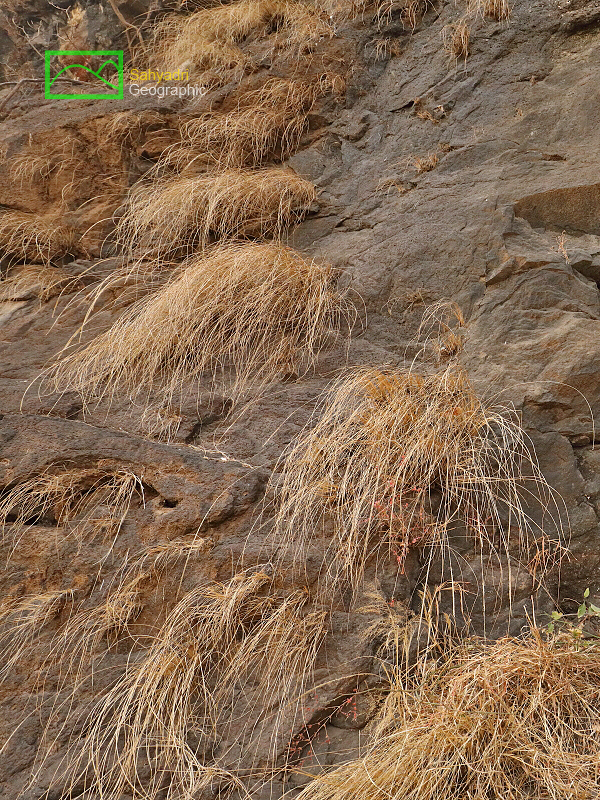 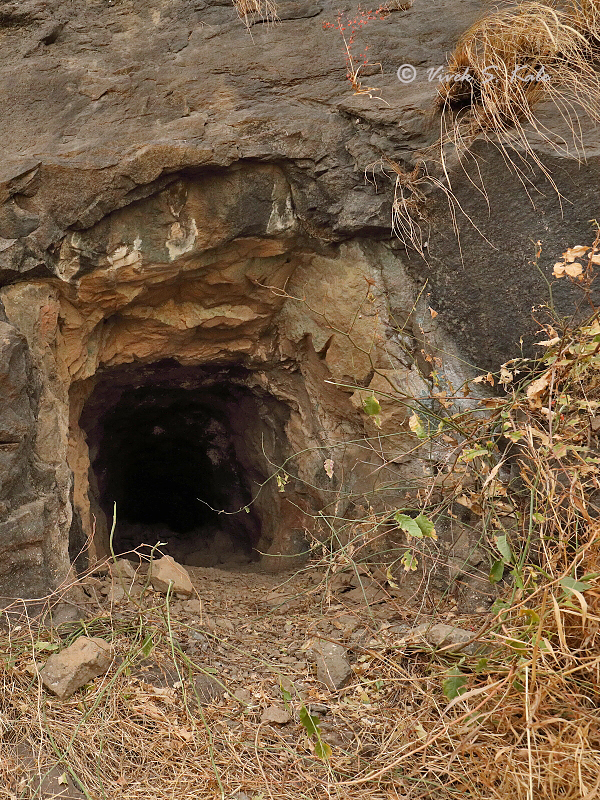 |
| |
| 1. Velhavali Tunnel Cave, Maval Tehsil, Pune district, Maharashtra, India |
| |
|
|
| |
  |
| |
| 2. Map of Velhavali-Khandshi Region, Maval Tehsil, Pune district, Maharashtra, India |
| |
|
|
| |
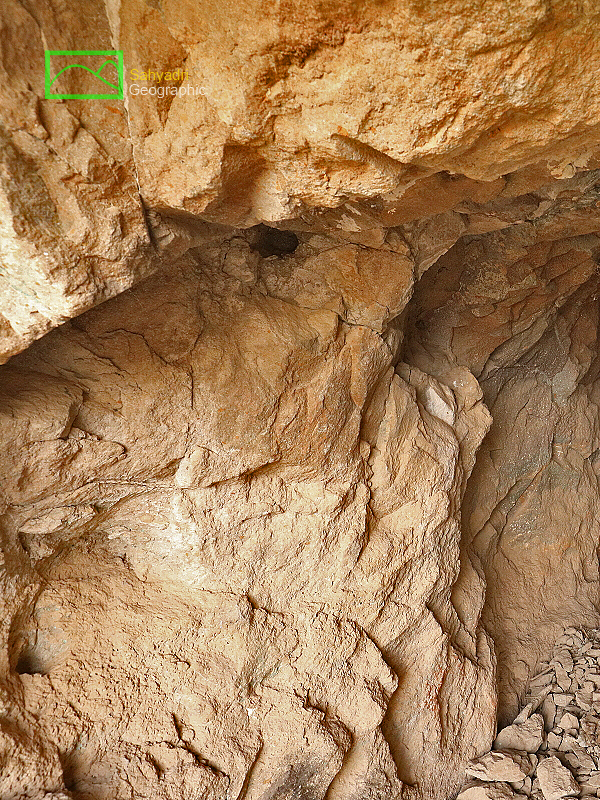  |
| |
| 3. Velhavali tunnel Cave, Maval Tehsil, Pune district, Maharashtra, India |
| |
|
|
वेल्हवली आणि खांडशी नावाची दोन इवलीशी गाव नाणे मावळाच्या शिरोटा भागात आहेत. कार्ले डोंगररांग पश्चिम घाटाच्या मुख्य रांगेपासुन पुर्वेकडे असलेल्या वाळख गावापर्यंत पसरलेली आहे. कामशेत गावातुन या भागात जायला रस्ता आहे. इंद्रायणी नदी ओलांडल्यावर उत्तरेकडे शेतांमधुन एक अरुंद गाडीवाट शिरोटा धरणाकडे जाते. रस्त्याला संमांतर टाटा पावर कंपनीची खाजगी रेल्वे लाईन आहे. मागच्या वर्षापर्यंत चालु असलेली ही रेल्वे आता मात्र बंद झाली आहे. शिरोटा धरण १९१६ साली बांधण्यात आले. त्यापूर्वी या खोऱ्यातुन थेट राजमाची किल्याच्या वाटेवर असलेल्या फणसराई गावापुढे वाट जात होती. धरण झाल्यामुळे ही वाट आता तुटली आहे. कार्ले डोंगररांगेच्या उत्तर बाजूस वेल्हवली, खांडशी, भाजगाव, नेसावे ही लहान गाव आहेत. वेल्हवली आणि खांडशी गावांजवळ डोंगरात उंचावर कातळात तीन ठिकाणी भुयार लेणी आहेत.
|
|
Velhavali and Khandshi are two small villages in Maval Taluka of Pune district, in Maharashtra state in India. The village is located near Karle hill range. Karle hill range is spread from western ghat ridge north of Lonavala to Walakh village to east. South of Karle hill range, there is Indrayani river basin. On the north side of the hill range there is a Shirota Lake. Apart from Shirota lake the region is dotted with villages such as Velhavali, Khandshi, Nesave and Bhajgav. Shirota Dam was constructed in 1916. Prior to the existance of the lake, this basin was connected to Konkan via Rajmachi fort. Near the northern flank of the Karle range, there are three villages namely; Velhavali, Nesave and Khandshi. These villages are connected to the Pune-Mumbai national highway by a narrow road from Kamshet, which passes through the fields parallel to the old private TATA railway line. High up on the hills near Vehavali and Khandshi there are total three strange tunnel caves.
|
|
|
| |
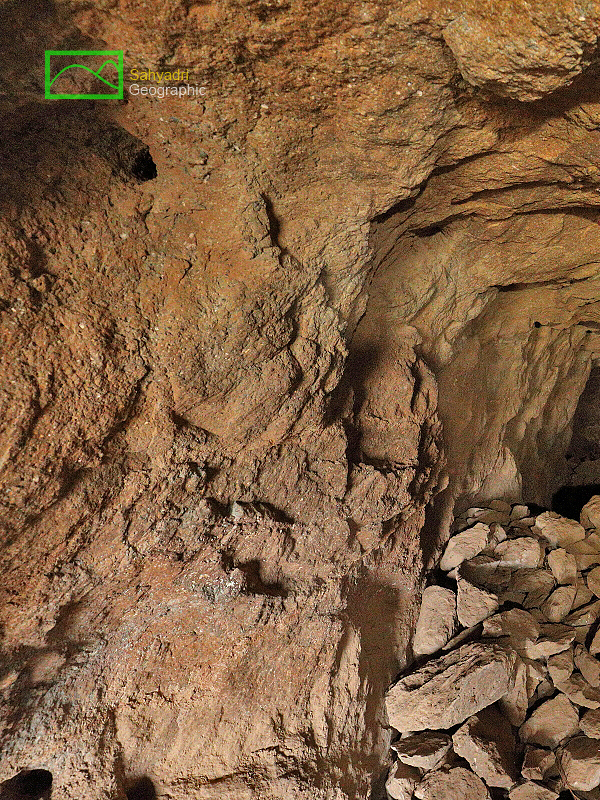 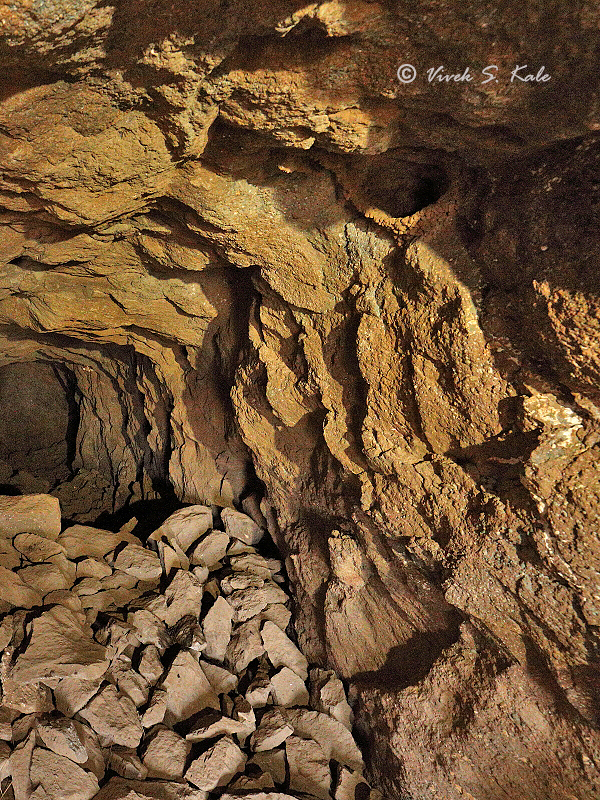 |
| |
| 4. Velhavali Tunnel Caves, Maval Tehsil, Pune district, Maharashtra, India |
| |
|
|
वेल्हवली भुयार लेणे :
वेल्हवली गावापासुन थोडे दुर असलेल्या कार्ले डोंगररांगेत, कातळात एक भुयार लेणे आहे. या भुयार लेण्याच्या आसपास कुठेही देवाचे ठाणे, वस्ती, पाण्याचे टाके अथवा इतर मानवनिर्मीत रचना आढळत नाही. हे भुयार लेणे अत्यंत एकांतवासात आहे. या भुयार लेण्यात एक मुख्य भुयार आहे. सरळ असलेले हे मुख्य भुयार अंदाजे ४५ फूट लांब आहे. प्रवेशद्वाराजवळ भुयाराची उंची माणुस जेमतेम चालत जाईल एवढी आहे. भुयाराला डावीकडे आणि उजवीकडे दोन जोड शाखा आहेत. गावापासुन अंदाजे ६०-७० मीटर उंचीवर असलेल्या भुयारात माणसाने केलेल्या ड्रिल च्या खुणा दिसतात. ज्वालामुखी झाल्यावर तयार होणाऱ्या भुरचनेतल्या वायु वाहुन जाताना तयार झालेल्या नळीचा भुयार करण्यासाठी वापर झाला असावा. गावापासुन दूर खुप झाडीझुडपात लपलेल्या भुयाराचा निश्चित वापर कशासाठी होत असावा, याचा मागमूस मात्र लागत नाही.
|
|
Velhavali Tunnel Cave :
The tunnel cave near village Velhavali is located high up in the hill in the scarp facing north west. In the middle of a forest there are no other structures around the cave such as temple, deity or water cistern. The cave is tunnel type and has main tunnel along with two side branches to it. The manmade drill marks in rocks to convert what was probabaly a natural volcanic gas void or a gas duct, in to a cave can be seen everywhere inside the tunnel cave. These long cylindrical marks are about 30-35 cm in diameter. The velhavali cave is located at about 60-70 meter above the village level. Though the cave can be seen from the distance it is hidden in the thorny bush forest below the scarp. The tunnel is mysterious with no traces of human use of it. It looks incomplete. The main tunnel is about 45 feet in length, and is high enough for the person to just stand or walk without hitting the head to the ceiling.
|
|
|
| |
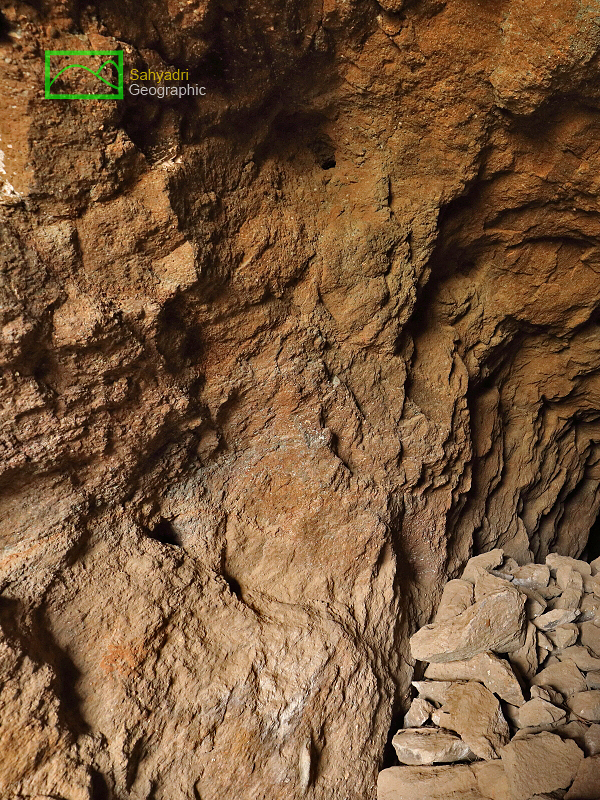 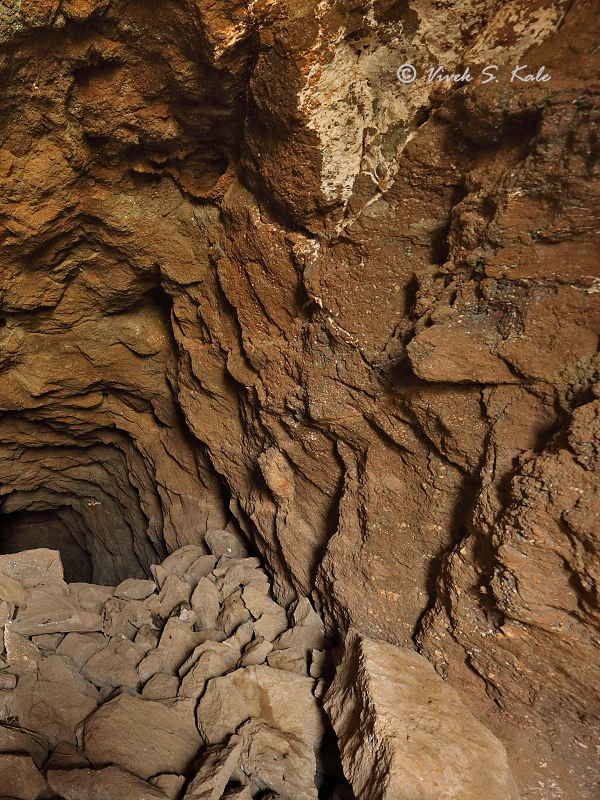 |
| |
| 5. Velhavali tunnel Caves, Maval Tehsil, Pune district, Maharashtra, India |
| |
|
|
| |
 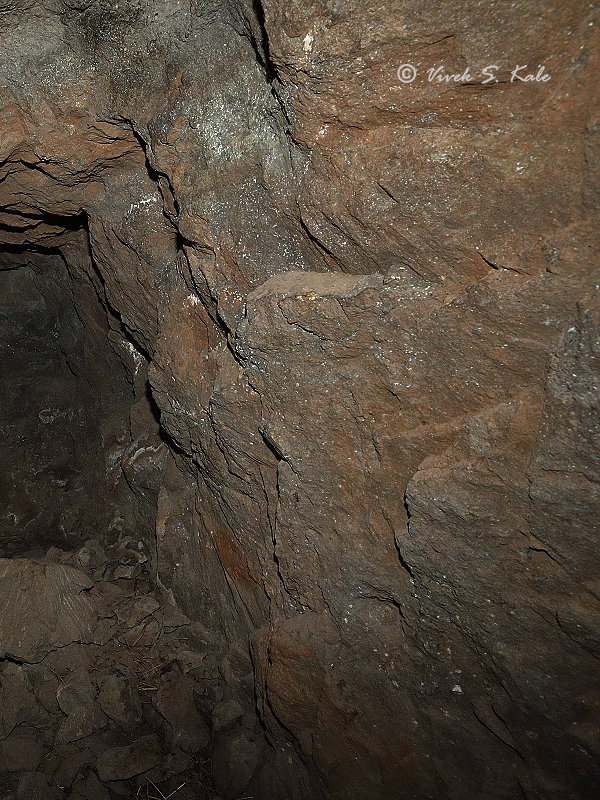 |
| |
| 6. Velhavali Tunnel Cave, Maval Tehsil, Pune district, Maharashtra, India |
| |
|
|
मुख्य भुयाराला दोन शाखा आहेत. विरुद्ध दिशेला असलेल्या या भुयार शाखा लहान असुन त्यांची लांबी १२-१३ फूट आहे. या भुयारातील एकुण खोदिव कामाची लांबी ७० फूट आहे. या भुयारात असंख्य दगड पडलेली आहेत. अर्धवट खोदलेले हे भुयार लेणे बनवण्याच्या मागे काय उद्देश असावा, असा प्रश्न येथे मनात सतत घोंगावतो.
|
|
There are two side branches to the main tunnel. Both these side branches are in opposite direction to each other, and are short in length. Both the tunnel branches are about 12 to 13 feet in length on either side of the main tunnel. So the total tunneling work in this cave is about 70 feet in length. Lot of loose rocks are lying in the tunnel suggesting that the excavation was left incomplete. Only the stretched imagination can help us to guess the purpose of such caves as there is hardly any prior study of these tunnel caves.
|
|
|
| |
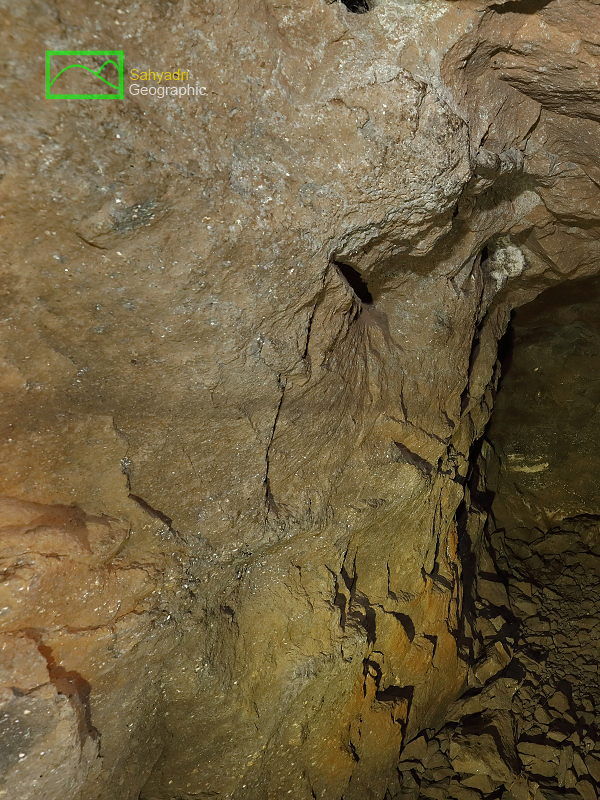 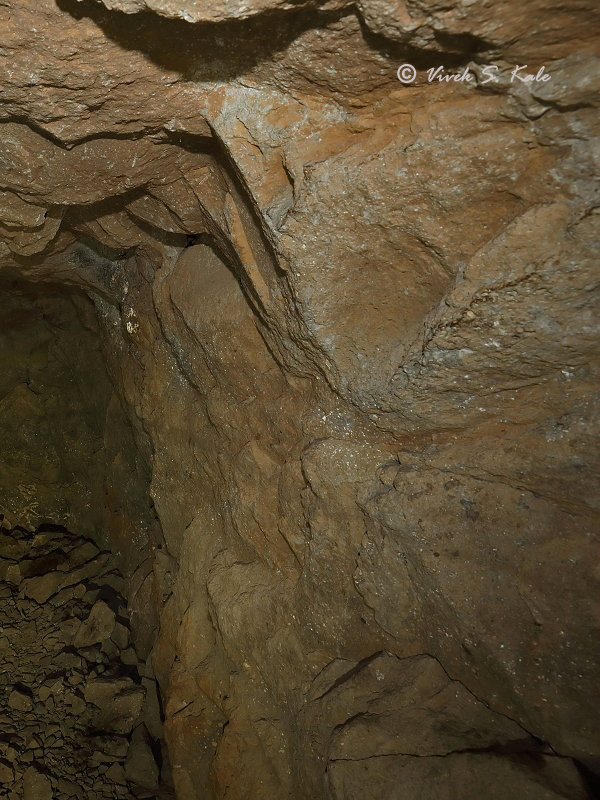 |
| |
| 7. Velhavali tunnel cave, Maval Tehsil, Pune district, Maharashtra, India |
| |
|
|
| |
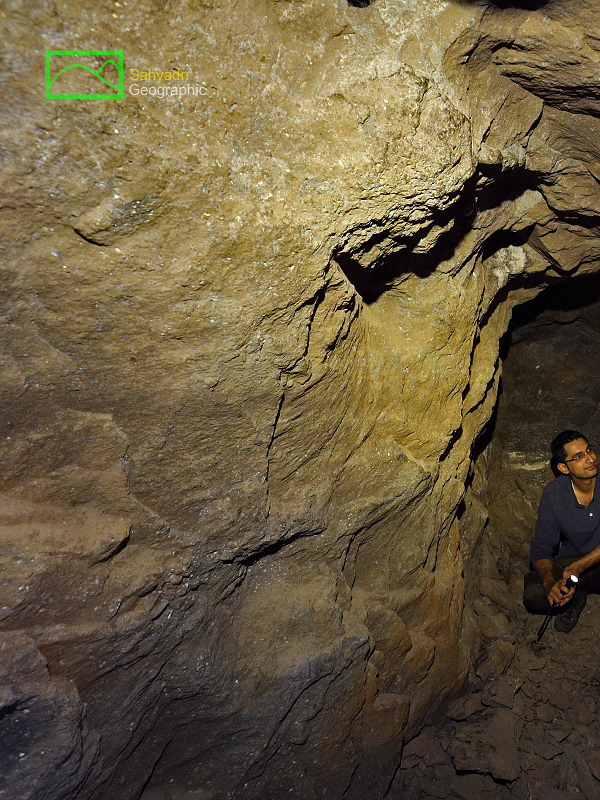 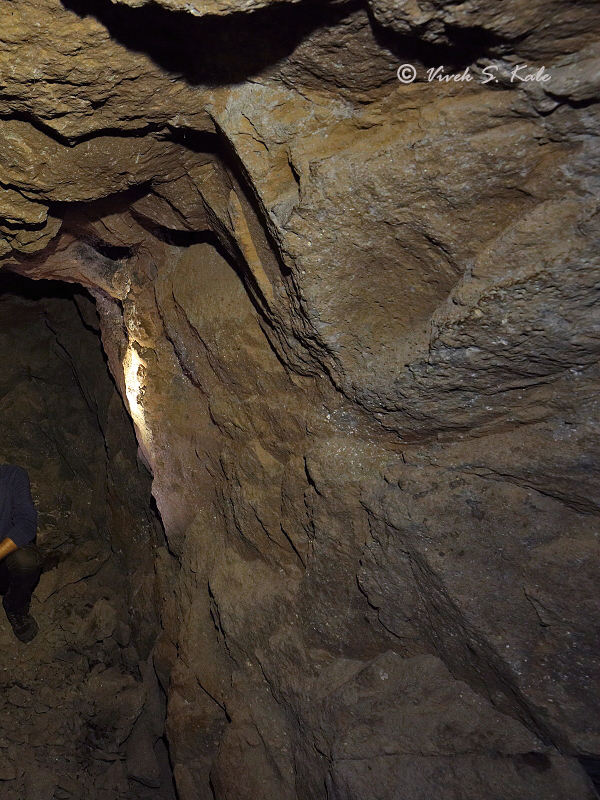 |
| |
| 8. Velhavali tunnel cave, Maval Tehsil, Pune district, Maharashtra, India
|
| |
|
|
| |
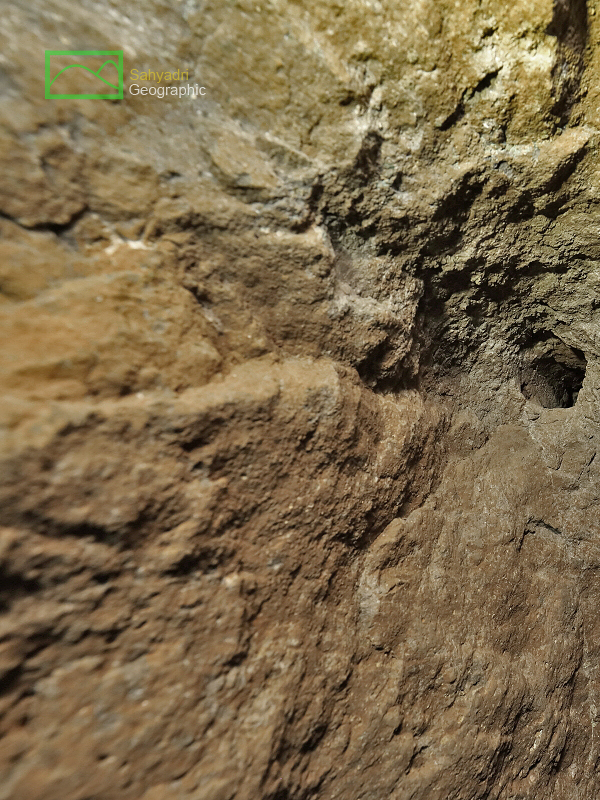  |
| |
| 9. Velhavali tunnel caves, Maval Tehsil, Pune district, Maharashtra, India |
| |
|
|
| |
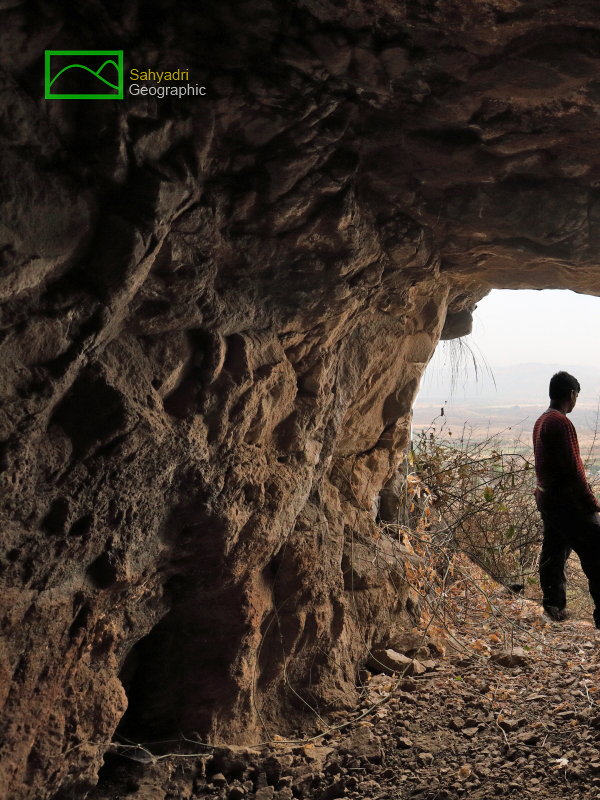  |
| |
| 10. Velhavali Cave, Maval Tehsil, Pune district, Maharashtra, India |
| |
|
|
| |
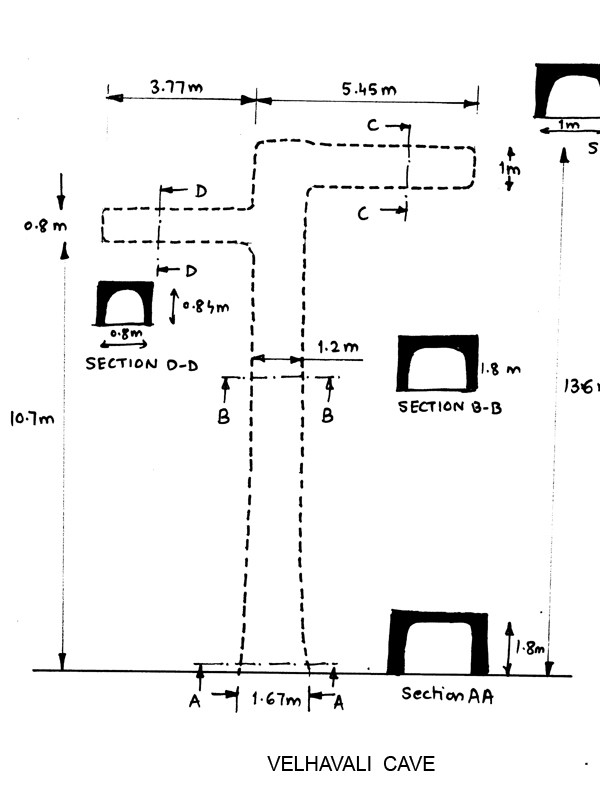  |
| |
| 11. Layout of Velhavali Tunnel Cave, Maval Tehsil, Pune district, Maharashtra, India |
| |
|
|
| |
 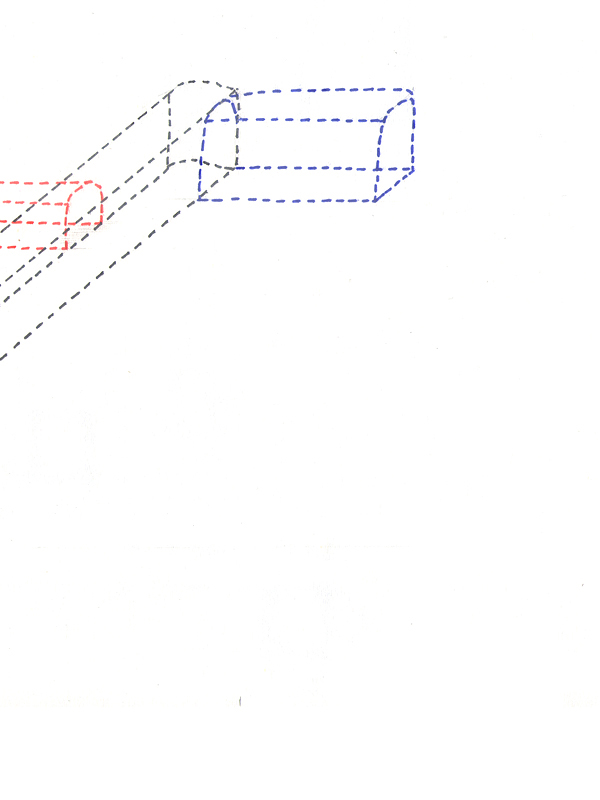 |
| |
| 12. Layout of Velhavali Tunnel Cave, Maval Tehsil, Pune district, Maharashtra, India |
| |
|
|
| |
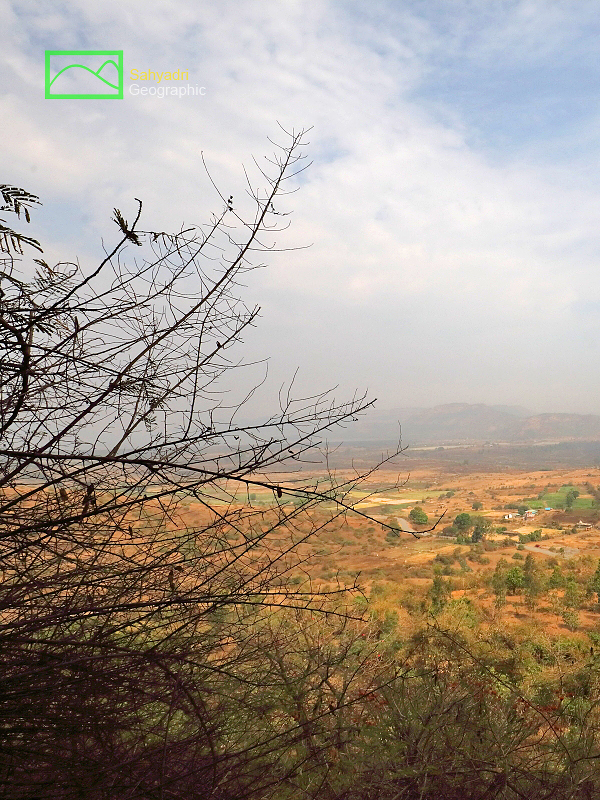 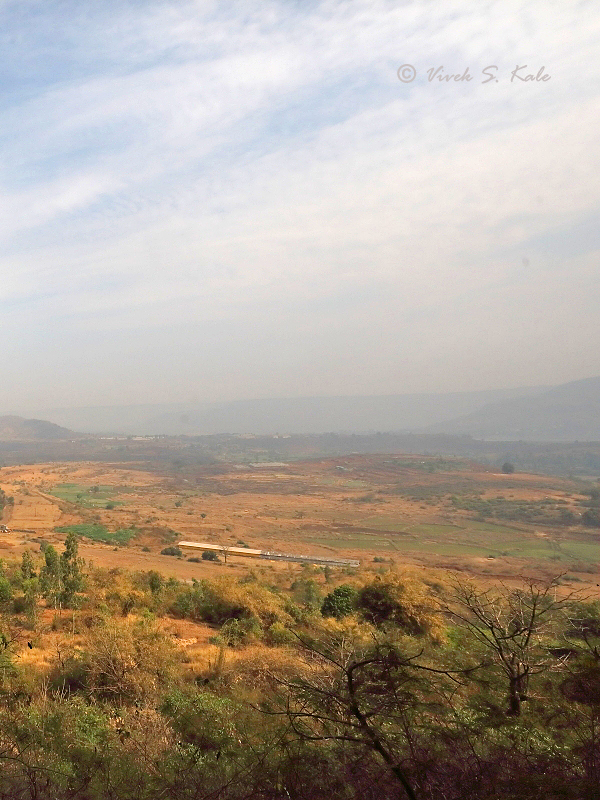 |
| |
| 13. View from Velhavali Tunnel Caves, Maval Tehsil, Pune district, Maharashtra, India |
| |
|
|
| |
  |
| |
| 14. Nesave well, Maval Tehsil, Pune district, Maharashtra, India |
| |
|
|
| |
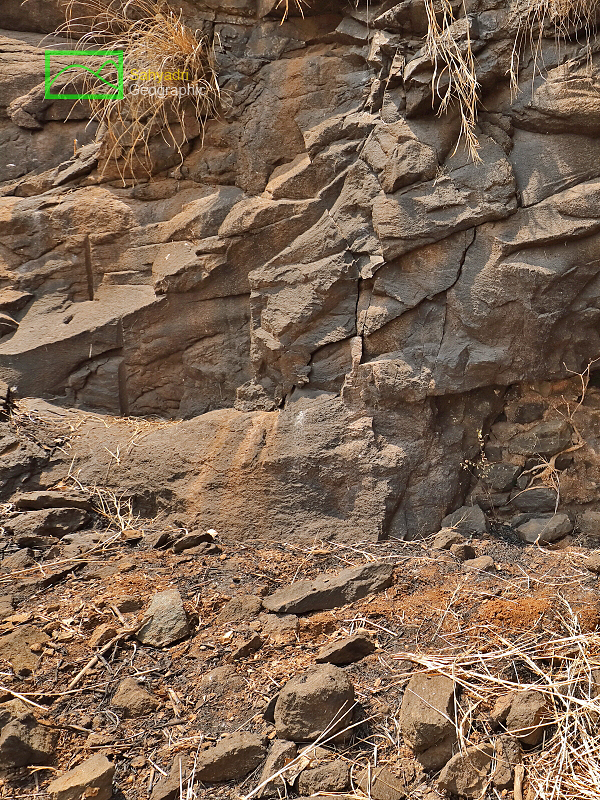  |
| |
| 15. Khandshi Tunnel Cave-1, Maval Tehsil, Pune district, Maharashtra, India |
| |
|
|
खांडशी भुयार
खांडशी गावाजवळ कार्ले डोंगररांगेत, गावापासून अंदाजे ६०-७० मीटर उंचीवर दोन भुयार लेणी आहेत. या भुयारांच्या जवळ देवाचे ठाणे, पाण्याचे टाके किंवा इतर कोणतीही मानवनिर्मित रचना नाही. भुयारांच्या सरळ भागाला काटकोनात वळणाऱ्या भुयार शाखा आहेत. भुयारांचे मुख खुप लहान आहे. माणुस जेमतेम रांगत जाऊ शकेल एवढ्याच आकाराचे भुयाराचे प्रवेशमुख आहे. भुयार गुढ आहेत. वेल्हवलीच्या भुयारापेक्षा खांडशी ची भुयार अरुंद व उंचीला कमी आहेत. त्यामुळे ही भुयार दुरुन सहज दिसत नाहीत. गावापासुन अंदाजे ६०-७० मीटर उंचीवर असलेल्या भुयारात माणसाने केलेल्या ड्रिल च्या खुणा दिसतात. ज्वालामुखी झाल्यावर तयार होणाऱ्या भुरचनेतल्या वायु वाहुन जाताना तयार झालेल्या नळीचा भुयार करण्यासाठी वापर झाला असावा.
|
|
Khandshi Tunnel Caves :
The tunnel caves near village Khandshi are located high up in the hill in the scarp facing north east. In the middle of a forest there are no other structures around the caves such as temple, deity or water cistern. The caves are tunnel type and have main tunnel along side branches to it. The manmade drill marks in rocks to convert what was probabaly a natural volcanic gas void or a gas duct, in to a cave can be seen everywhere inside the tunnel cave. These long cylindrical marks are about 30-35 cm in diameter. The Khandshi caves are located at about 50-60 meter above the village level. The main entrances of these tunnel caves are so small that unless one reaches in front of it, the caves can noy be spotted from the distance. The tunnel is mysterious with no traces of human use of it. The inner walls of the tunnels are not flat finished and look incomplete.
|
|
|
| |
  |
| |
| 16. Khandshi Tunnel Cave-1, Maval Tehsil, Pune district, Maharashtra, India |
| |
|
|
| |
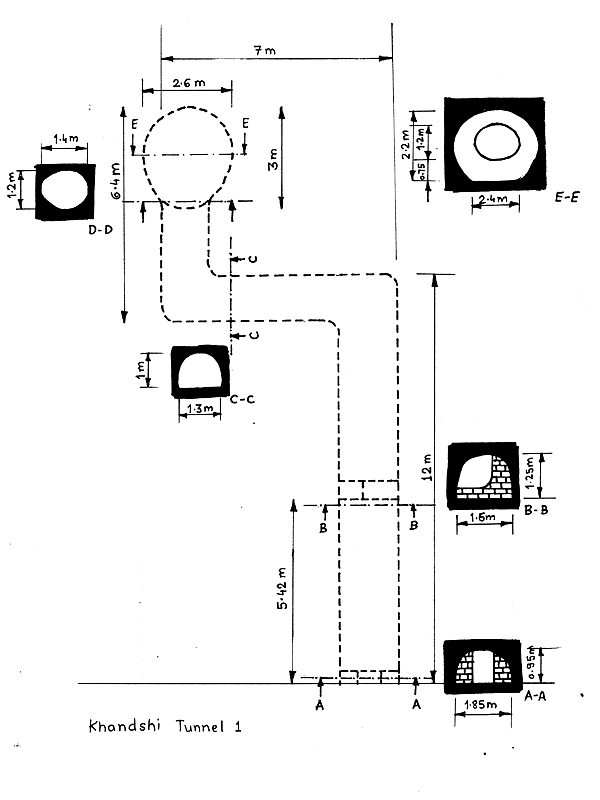  |
| |
| 17. Khandshi Tunnel Cave-1, Maval Tehsil, Pune district, Maharashtra, India |
| |
|
|
खांडशी भुयार लेणे १ :
येथील मुख्य भुयार ७५ फूट लांब आहे. माणसाला आत जाताना रांगत जावे लागते. हे भुयार सरळ नाही. यात दोन ठिकाणी वळणे आहेत. पहिले डावे वळण ४० फूट अंतरावर आहे तर दुसरे उजवे वळण ५७ फूट अंतरावर आहे. सर्वात आत एक अंडाकार आकाराची खोली आहे. याचा व्यास अंदाजे २.६ ते ३ मीटर आहे. या भुयारात प्रवेशद्वाराजवळ आणि मध्ये दगडाची भिंत आहे.
|
|
Khandshi Tunnel Cave-1:
The main tunnel is about 75 feet in length, and is very small for the person to stand or walk without hitting the head to the ceiling. One needs to crawl in the tunnel to reach the interior part. The tunnel is not straight and has two turns, first to the left at about 40 feet distance and then to the right at about 57 feet distance. There is a spherical chamber with a circular flat base at the dead end of the tunnel. The chamber is large enough to stand, with diameter of about 2.6 to 3 meter. The cave has manmade rock wall structures at the entrance and at the intermediate stage.
|
|
|
| |
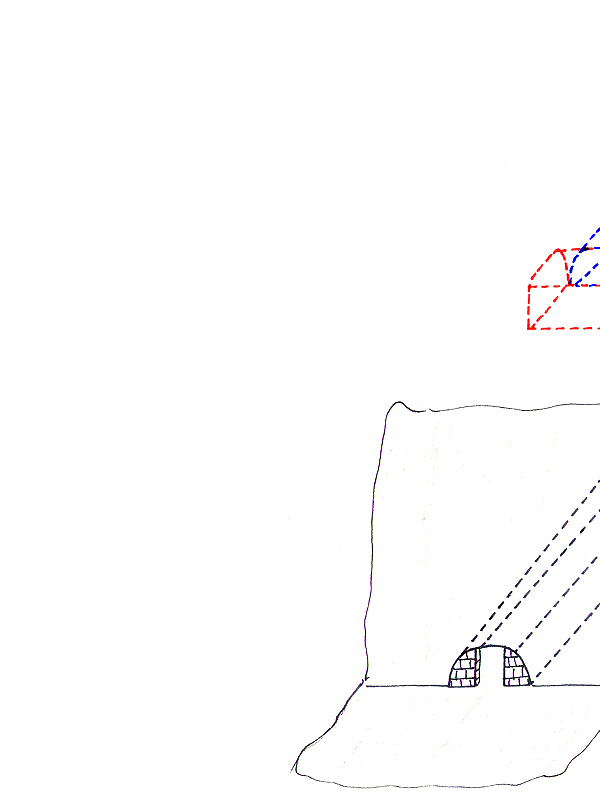 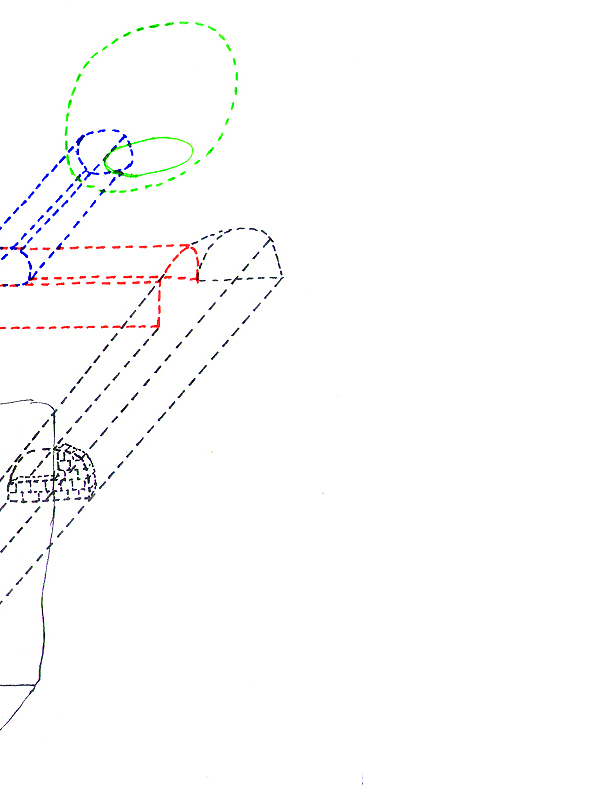 |
| |
| 18. Khandshi Tunnel Cave-1, Maval Tehsil, Pune district, Maharashtra, India |
| |
|
|
| |
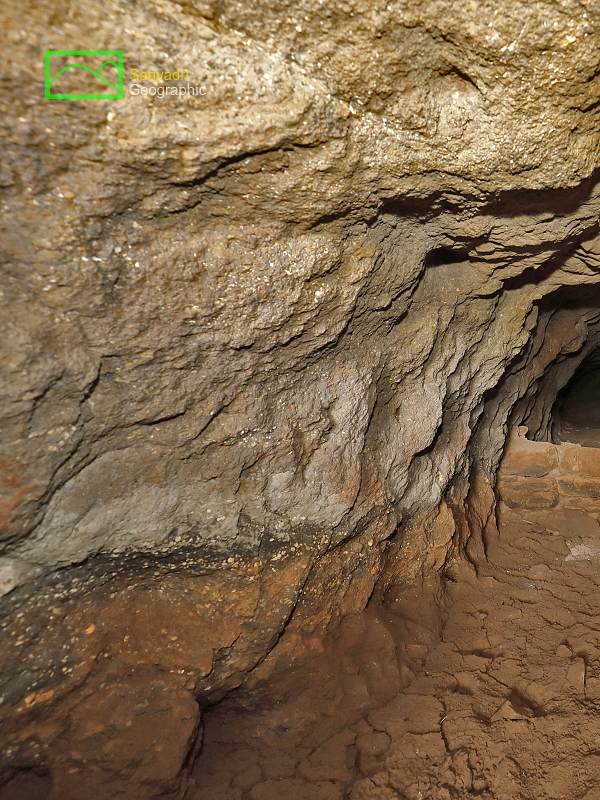 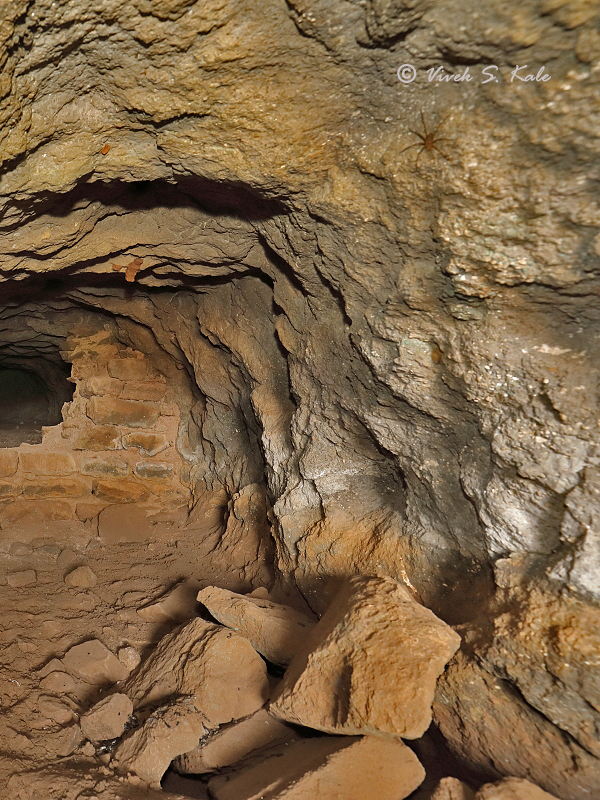 |
| |
| 19. Khandshi Tunnel Cave-1, Karle Caves, Maval Tehsil, Pune district, Maharashtra, India |
| |
|
|
| |
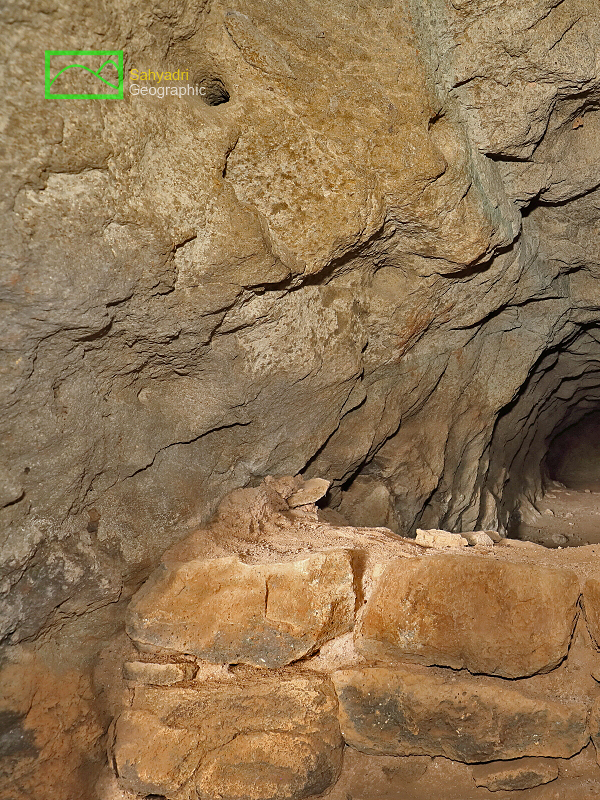 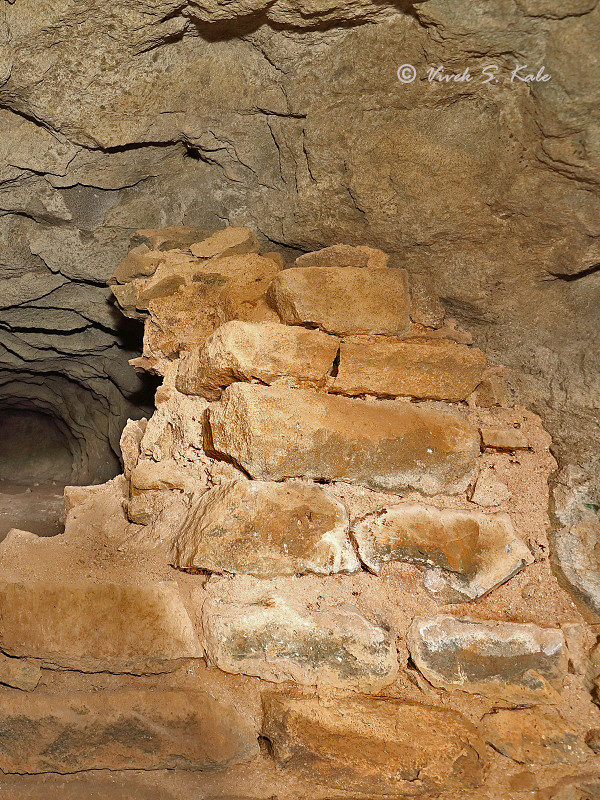 |
| |
| 20. Khandshi Tunnel Cave-1, Karle Caves, Maval Tehsil, Pune district, Maharashtra, India |
| |
|
|
| |
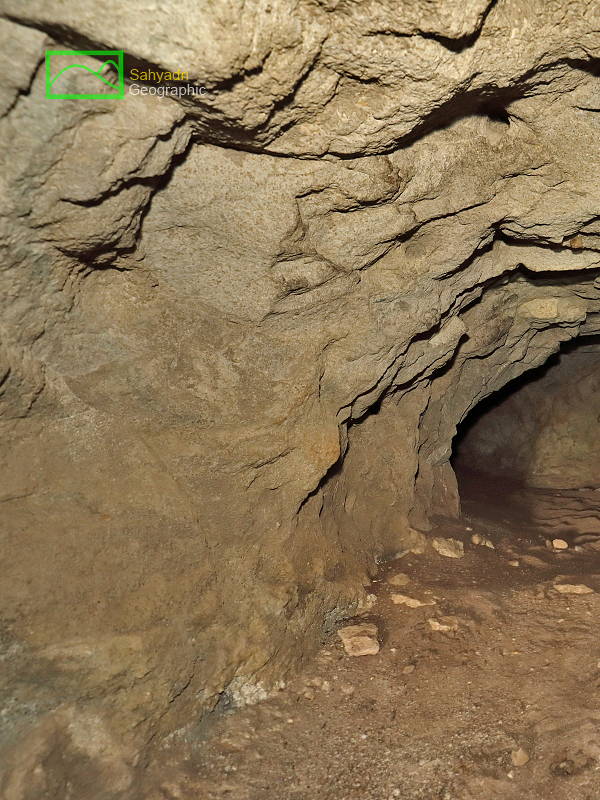 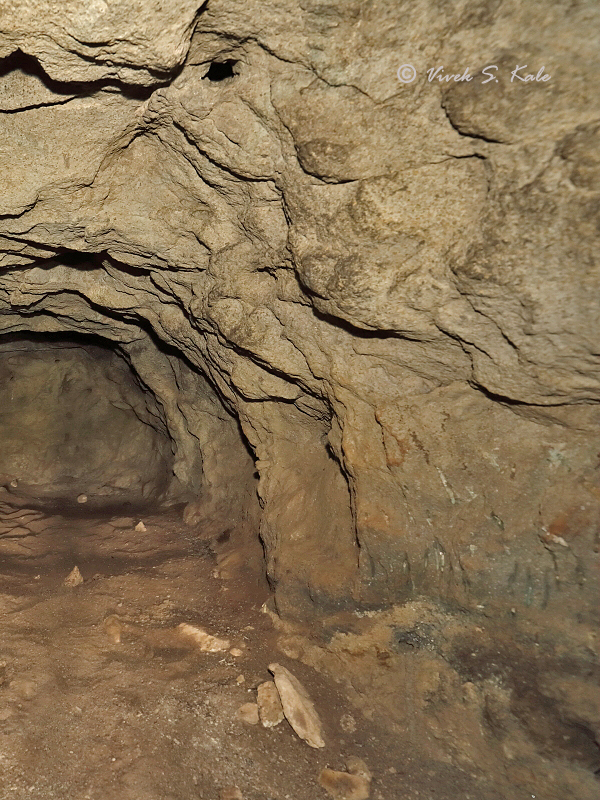 |
| |
| 21. Khandshi Tunnel Cave-1, Maval Tehsil, Pune district, Maharashtra, India |
| |
|
|
| |
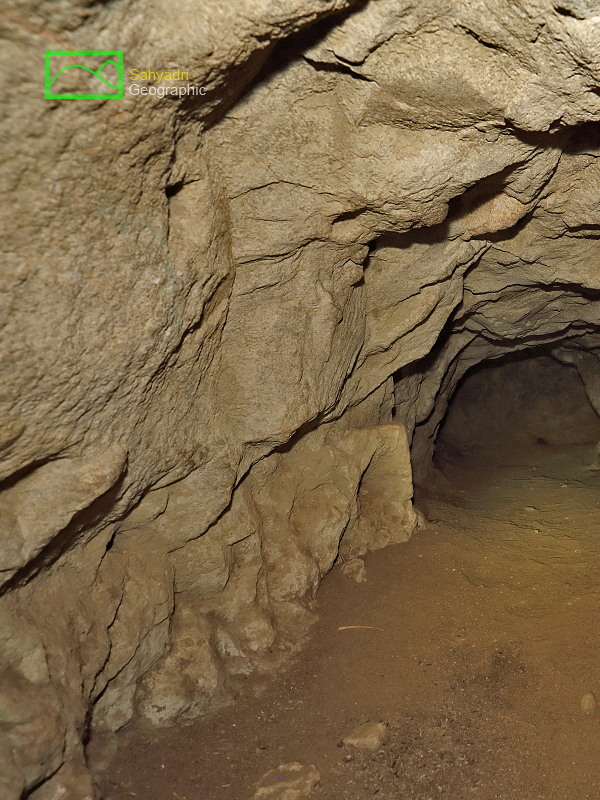  |
| |
| 22. Khandshi Tunnel Cave-1, Maval Tehsil, Pune district, Maharashtra, India |
| |
|
|
| |
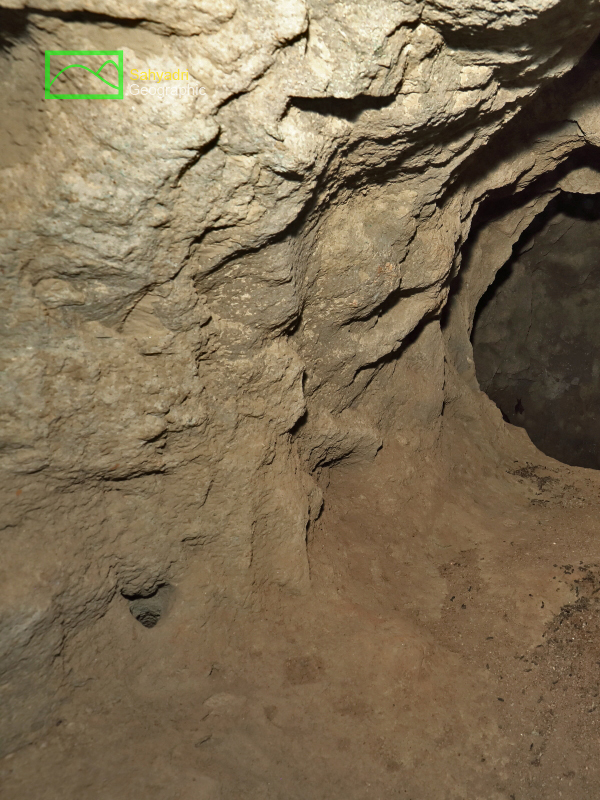 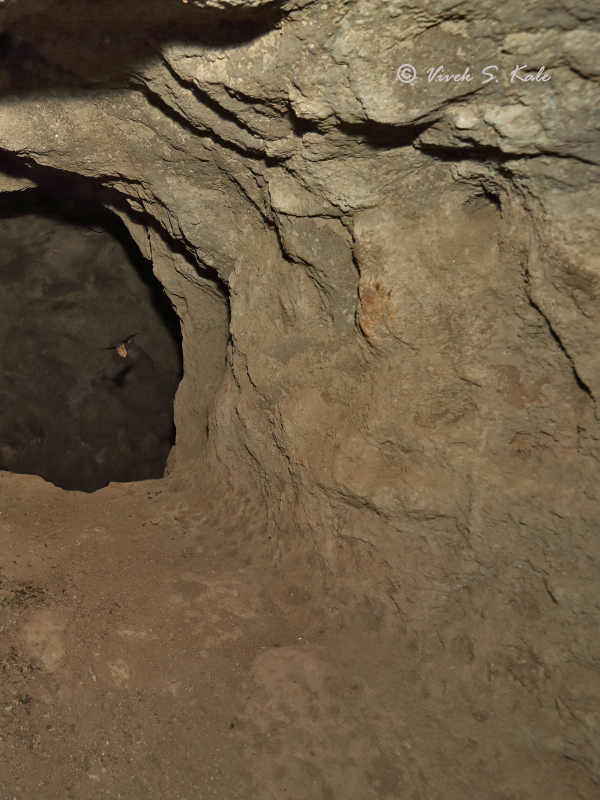 |
| |
| 23. Khandshi Tunnel Cave-1, Maval Tehsil, Pune district, Maharashtra, India |
| |
|
|
| |
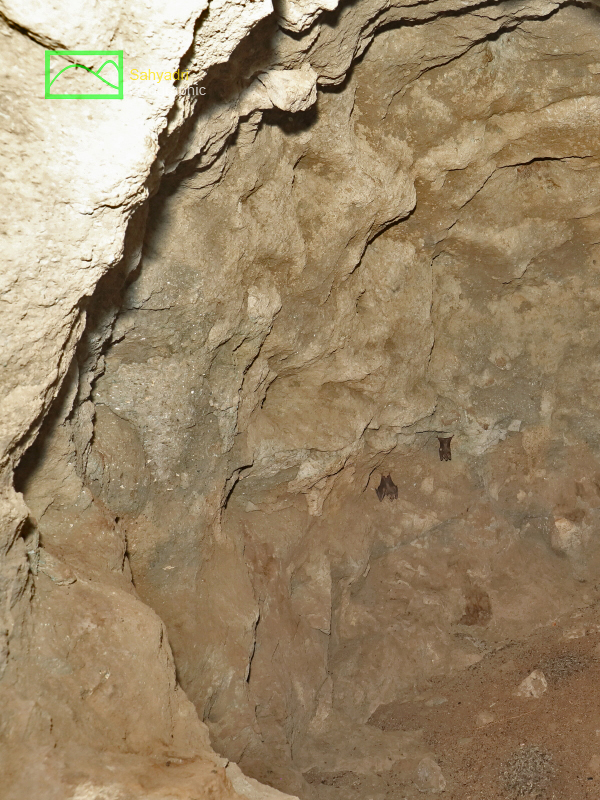 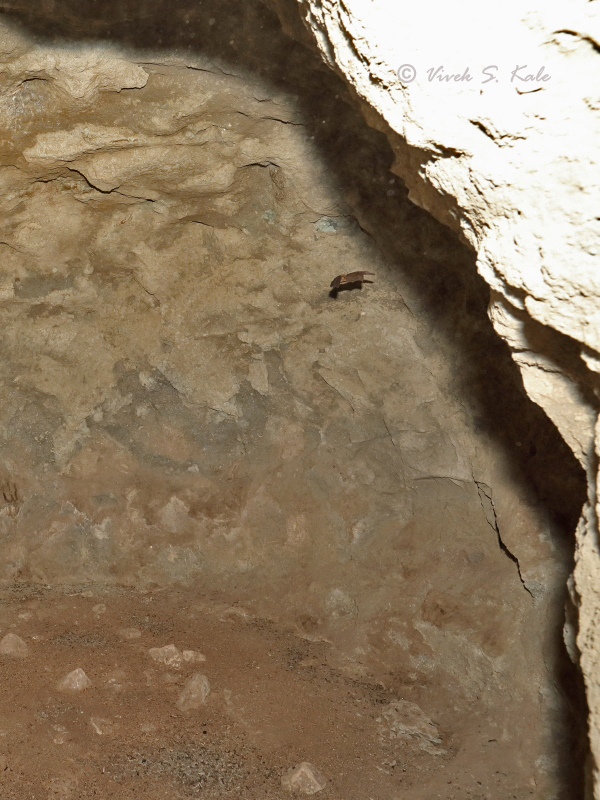 |
| |
| 24. Khandshi Tunnel Cave-1, Maval Tehsil, Pune district, Maharashtra, India |
| |
|
|
| |
 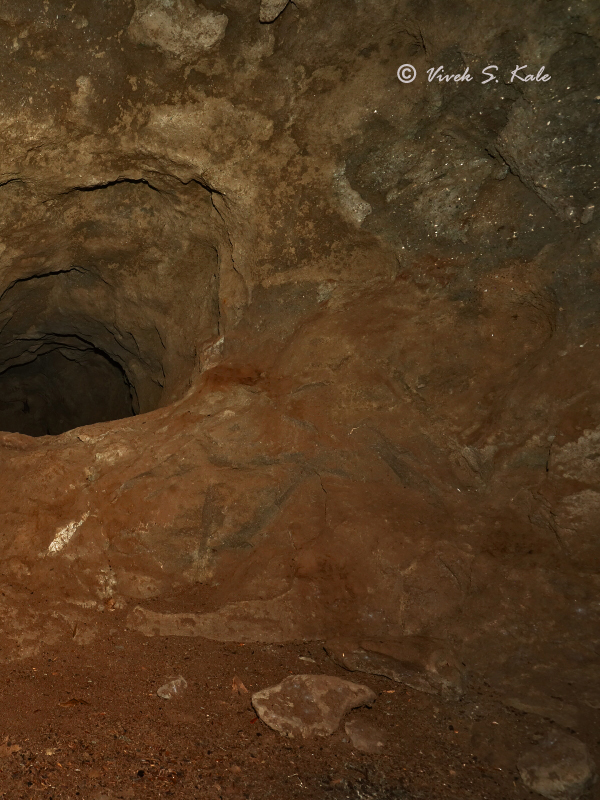 |
| |
| 25. Khandshi Tunnel Cave-1, Maval Tehsil, Pune district, Maharashtra, India |
| |
|
|
| |
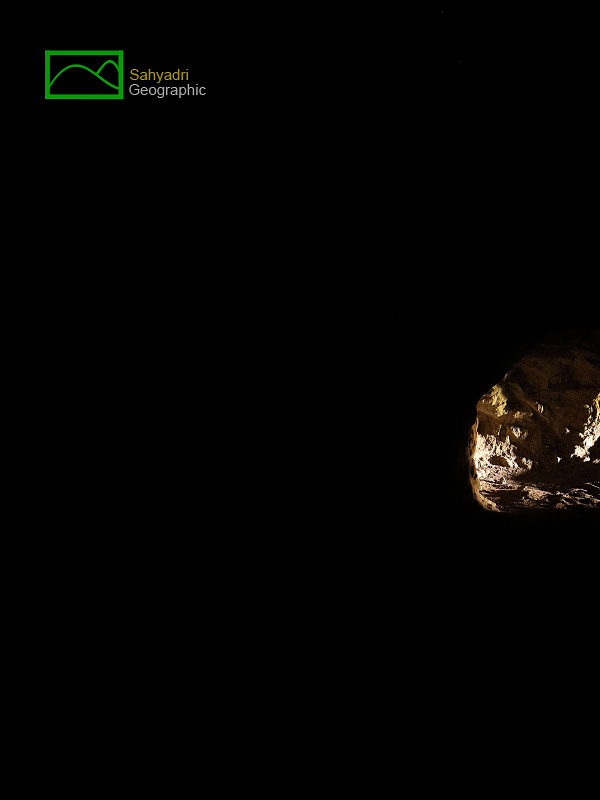 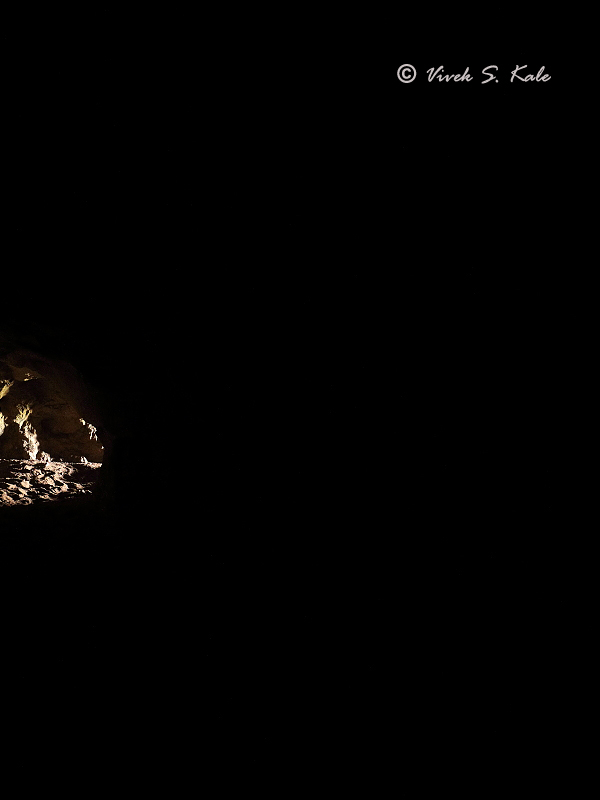 |
| |
| 26. Khandshi Tunnel Cave-1, Maval Tehsil, Pune district, Maharashtra, India |
| |
|
|
| |
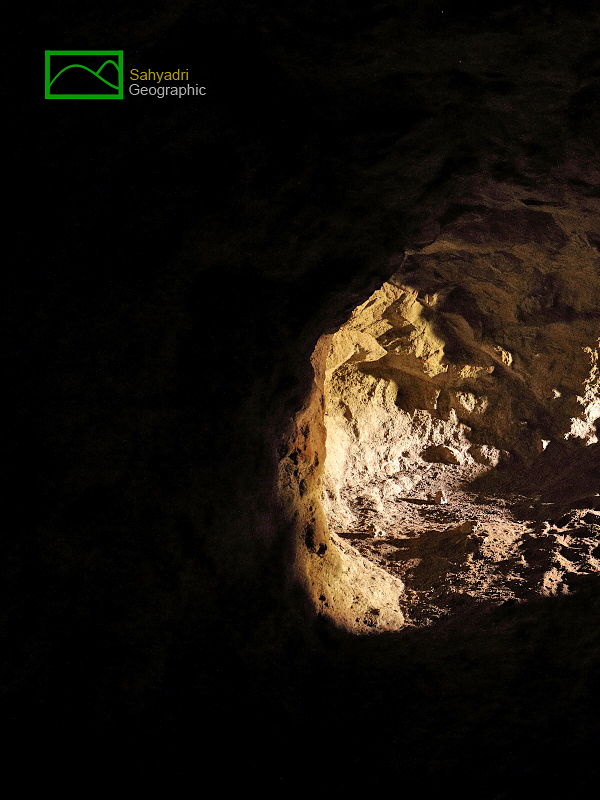  |
| |
| 27. Khandshi Tunnel Cave-1, Maval Tehsil, Pune district, Maharashtra, India |
| |
|
|
| |
 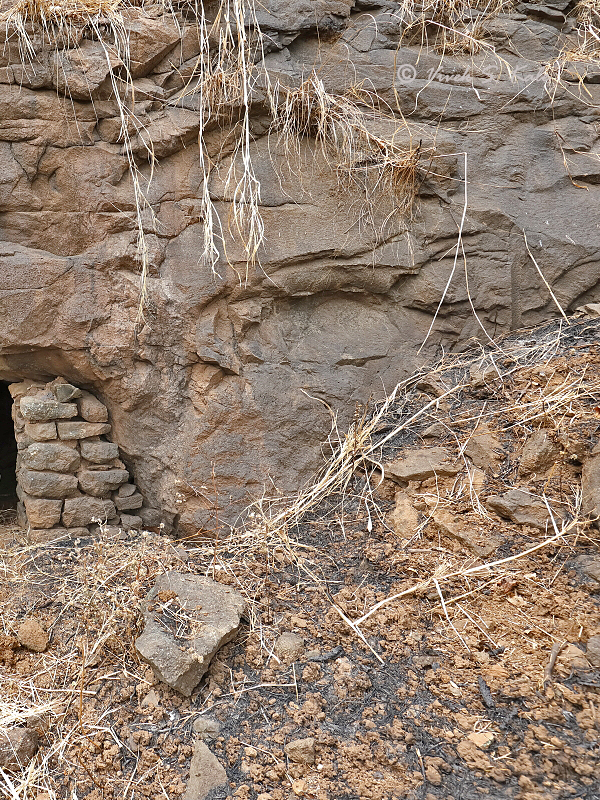 |
| |
| 28. Khandshi Tunnel Cave-1, Maval Tehsil, Pune district, Maharashtra, India |
| |
|
|
| |
 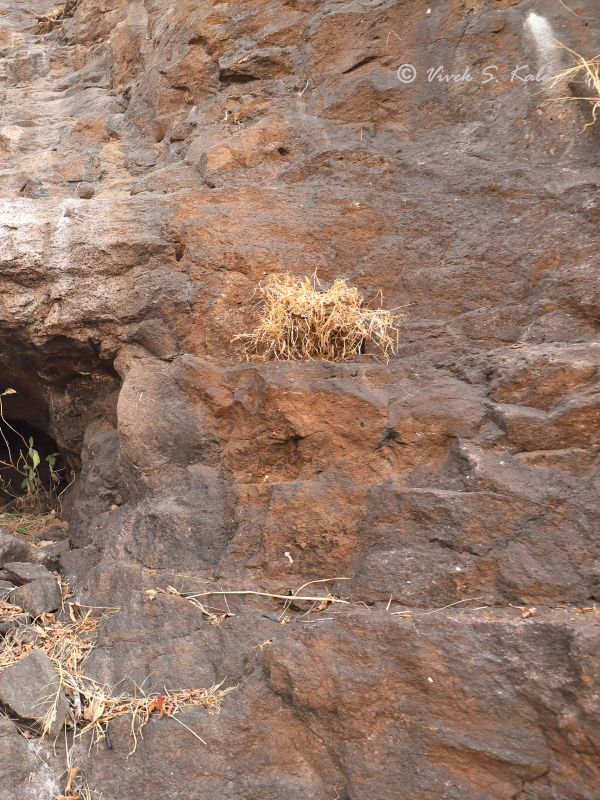 |
| |
| 29. Khandshi Tunnel Cave-2, Maval Tehsil, Pune district, Maharashtra, India |
| |
|
|
खांडशी भुयार लेणे 2 :
येथील मुख्य भुयार ३५ फूट लांब आहे. माणसाला आत जाताना रांगत जावे लागते. हे भुयार सरळ नाही. यात एका ठिकाणी उजवे वळण १५ फूट अंतरावर आहे. या भुयारात खुप दगड पडलेले आहेत. या भुयारात अंदाजे एकूण ६० फूट लांब खोदिव काम आहे.
|
|
Khandshi Tunnel Cave-2:
The main tunnel is about 35 feet in length, and is very small for the person to stand or walk without hitting the head to the ceiling. One needs to crawl in the tunnel to reach the interior part. The tunnel is not straight and has a side branch to the right at about 15 feet distance. There is very small spherical cavity on the right deadend. So the total tunneling work in this cave is about 60 feet in length. Lot of loose rocks are lying in the tunnel suggesting that the excavation was left incomplete.
|
|
|
| |
  |
| |
| 30. Khandshi Tunnel Cave-2, Maval Tehsil, Pune district, Maharashtra, India |
| |
|
|
अशी भुयार का बनवली असावीत या प्रश्नाचे उत्तर मिळणे अवघड आहे. परंतु काही शक्यतांचा तर्क करता येईल.
१) ध्यानगुंफा : भुयार ध्यानगुंफा असेल का ? खांडशी च्या पहिल्या भुयारात एक अंडाकृती खोली आहे. आज येथे वटवाघळांची एक टोळी राहाते. गुहेच्या प्रवेशद्वाराजवळ आणि आतल्या भगात असलेल्या भिंती कदाचीत वटवाघळ आणि इतर प्राणी आत येउ नयेत म्हणुन बांधल्या असाव्यात. आतल्या कक्षात गेल्यावर बाहेरचा आवाज आत पोहोचत नाही. खांडशी च्या गुहा ध्यान करण्यासाठी बनवल्या असाव्यात असे वाटते. नाथ संप्रदायाच्या अशा काही ध्यानगुंफा इतर ठिकाणी आढळतात.
२) भुगर्भातील तपासणी करण्यासाठी अशा प्रकारच्या चाचणी गुहा बनविल्या असाव्यात. कार्ले, बेडसे आणि भाजे सारख्या पुर्ण लेणी बनविण्याआधी अशी चाचणी केल्यामुळे लेणी बनविणे सोपे आणि शक्य होत असे. नंतर सापडलेल्या दगडातल्या त्रुटींमुळे, भेगांमुळे सर्व कष्ट वाया जाण्यापेक्षा अशी चाचपणी योग्य हे कालांतराने लेणी बनवणाऱ्यांच्या लक्षात आले असावे. लावा रस किंवा वायु वाहुन गेल्यामुळे तयार झालेल्या पोकळ नळ्य़ा व गुहांचा वापर केला असु शकतो.
३) शिकार : सह्याद्रीतील आदिवासी समाजातील शिकार करुन जगणारी माणस, साळिंदर इत्यादी प्राण्यांची शिकार नैसर्गिक गुहा कपारीत जाऊन करतात. या भुयार गुहा अशा लोकांनी पुर्वी शिकार करण्यासाठी तयार केलेले सापळे तर नव्हेत ना असा प्रश्न पडतो.
४) पश्चिम घाटातील काही किल्यांवर अशी भुयार आहेत. या किल्यांवर अशा भुयारांचा वापर पाणी साठवण्यासाठी होत असे. खांडशी आणि वेल्हवली च्या भुयार लेण्यात मात्र पाणी साठवण्याची सोय दिसत नाही.
५) लष्करी किंवा इतर वस्तु लपवण्यासाठी किंवा साठवण्यासाठी तर या भुयार गुहा बनवल्या नसतील ना ? असा अजुन एक प्रश्न मनात डोकावतो.
|
|
Purpose : Only the stretched imagination can help us to guess the purpose of such caves as there is hardly any prior study of these tunnel caves.
1) Meditation: One of the possible purposes might have been for the meditation. The cave at Khandshi has spherical chamber at the innermost deadend. Though there is bat colony residing in these tunnel caves now, the rock wall structures built on the Khandshi Tunnel Cave-1 probabaly look like these are built to avoid, bats, birds and other wild animals to enter the cave. The tunnel cave with few bends actuallt isolate the person inside completely from the external environment. Similar tunnel caves elesewhere associated with Nath Sampraday have been recorded.
2) Geological probing: One of the possibilities is to investigate the rock structure geologically to build a large cave complex, like one can see at Karle, Bedse and Bhaje. Such probing of the rock structure could have helped the cave makers to ensure that their efforts are not wasted after finding some rock defect leading water seepage. Unfinished probing cave can be seen at Tikona fort in Maval. However no obvious rock defect can be noticed here at Velhavali and Khandshi. The original volcanic gas/lava ducts may have been used to make the cave tunnel.
3) Hunting: The remote possibility of the use of caves for hunting can not be ruled out. Typically the aborginal communities residing in the Sahyadri hills in this region exploit the crevices of natural caves to hunt the wild animals such as porcupine etc.
4) Water cisterns: Use of these caves for storing the water is one possibility, but here at all these three caves there are no water cisterns or shallow chambers which can store the water. The long tunnel caves to store water can be seen at various forts in western Maharashtra.
5) Storage Chambers: The tunnels could have been used for storage of objects or to hide such as the tunnel caves seen at various forts in the region. But as there is no fort nearby, this possibility is very remote.
|
|
|
| |
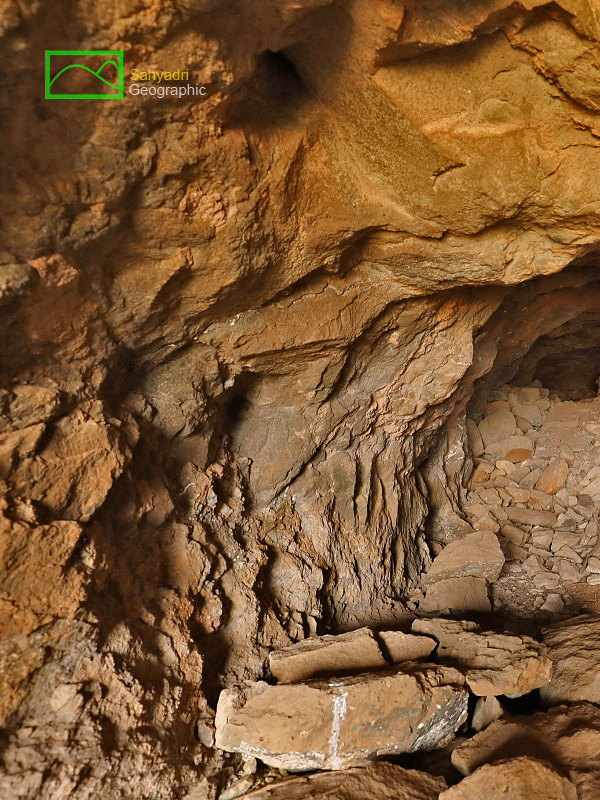  |
| |
| 31. Khandshi Tunnel Cave-2, Maval Tehsil, Pune district, Maharashtra, India |
| |
|
|
| |
 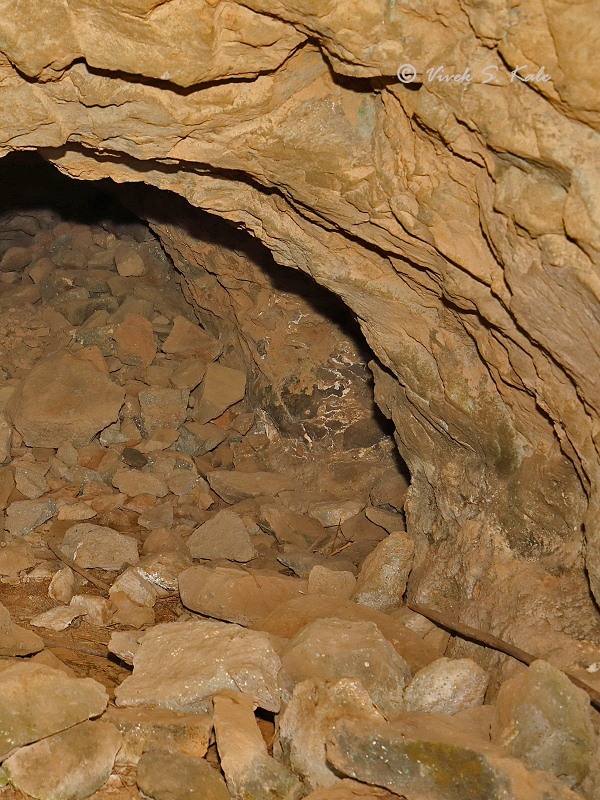 |
| |
| 32. Khandshi Tunnel Cave-2, Karle Caves, Maval Tehsil, Pune district, Maharashtra, India |
| |
|
|
| |
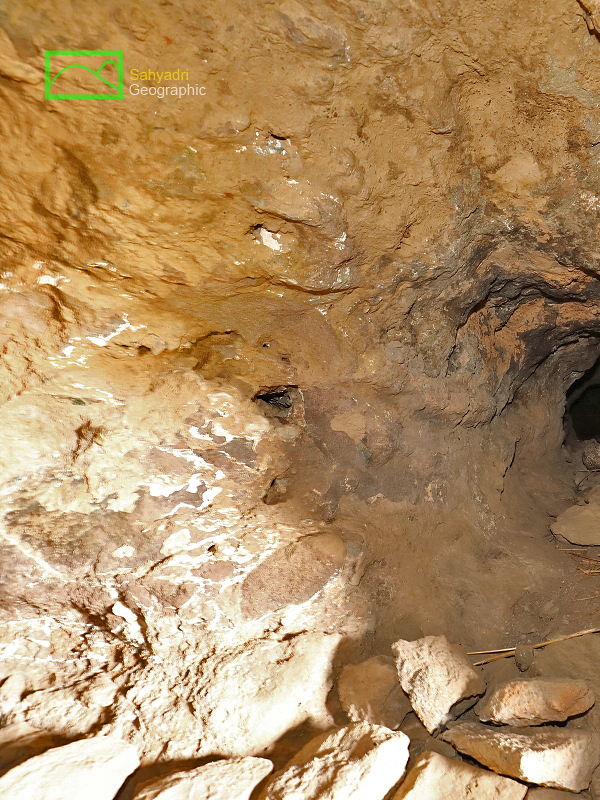 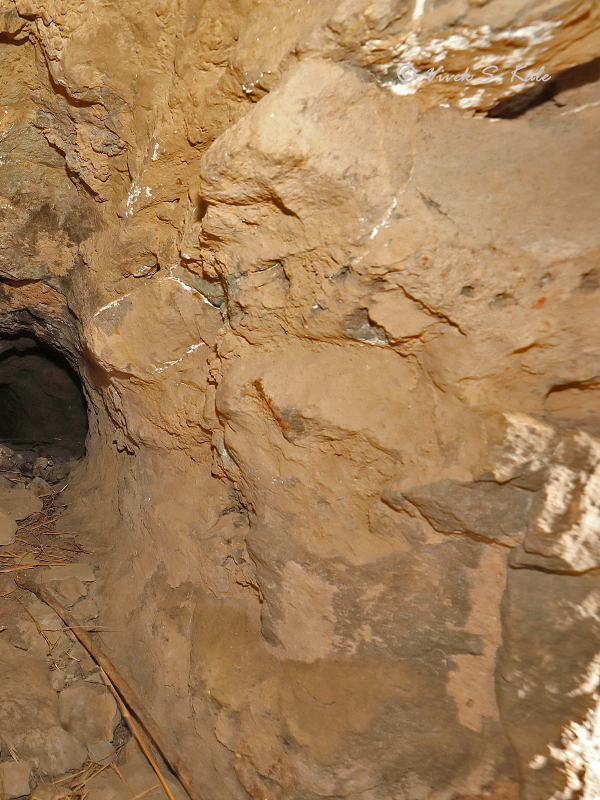 |
| |
| 33. Khandshi Tunnel Cave-2, Maval Tehsil, Pune district, Maharashtra, India |
| |
|
|
| |
 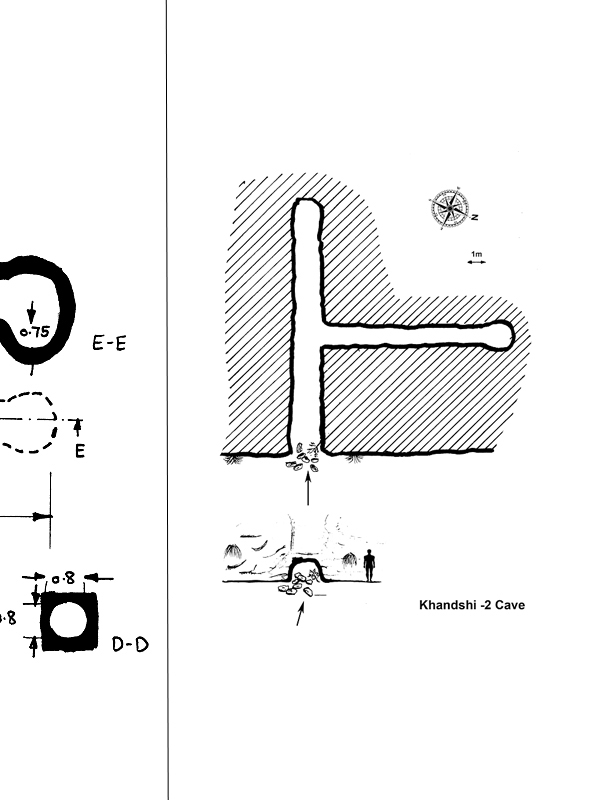 |
| |
| 34. Khandshi Tunnel Cave-2, Maval Tehsil, Pune district, Maharashtra, India |
| |
|
|
| |
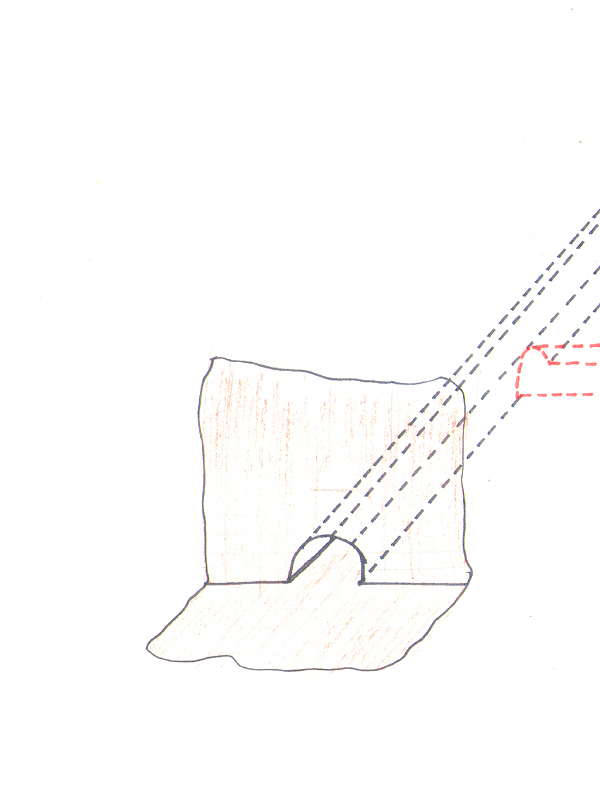  |
| |
| 35. Khandshi Tunnel Cave-2, Maval Tehsil, Pune district, Maharashtra, India |
| |
|
|
| |
 |
| |
|
|
References :
1. Cave temples of India, London, 1880, Fergusson James and Burgess James.
2. Gazetters of Bombay Presidency, Poona District, Volume XVIII, 1885.
|
| |
|
|
| |
|











































































